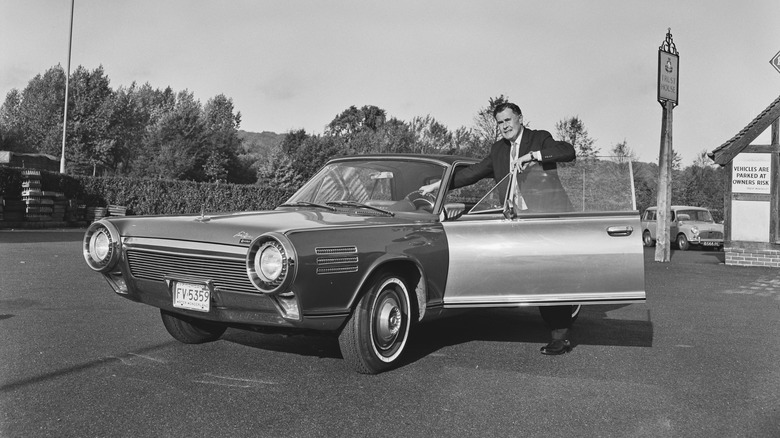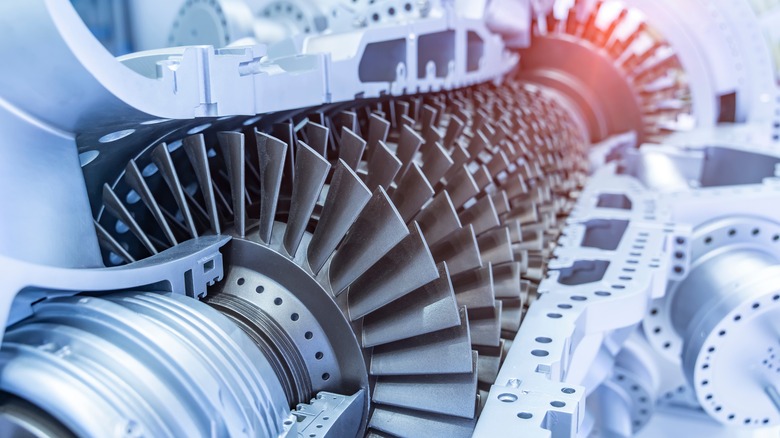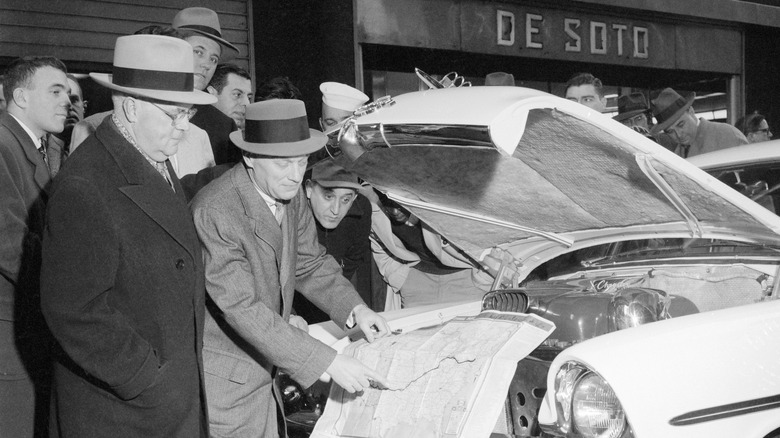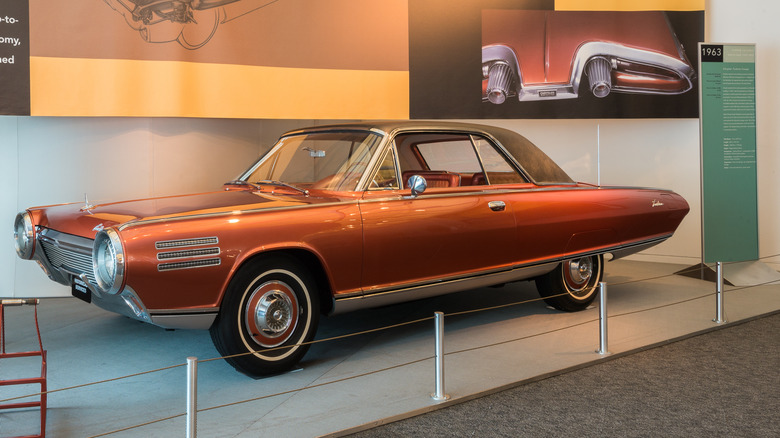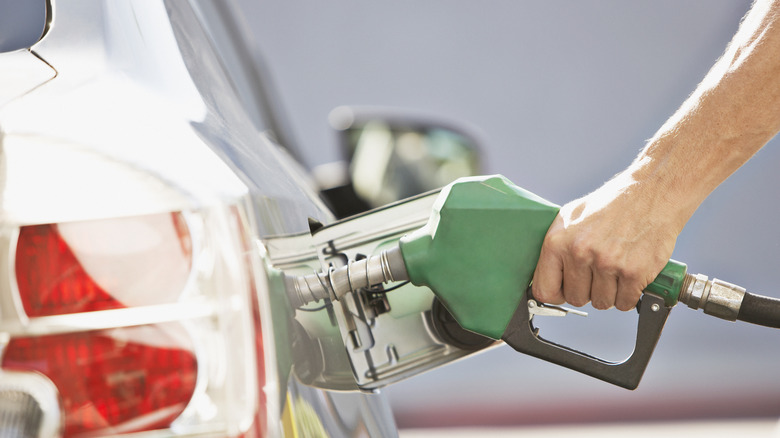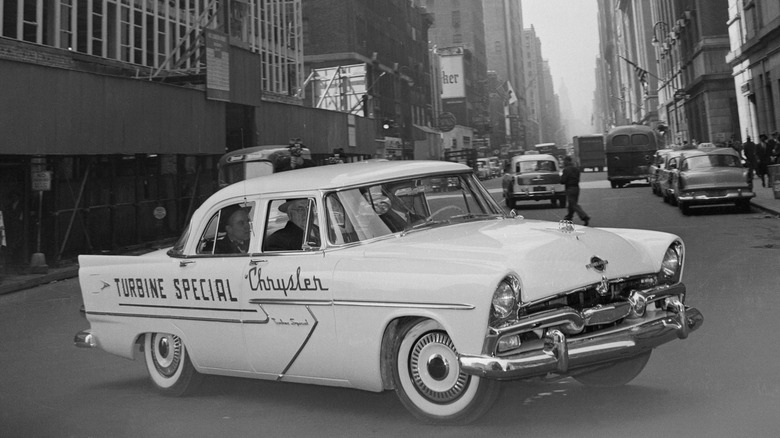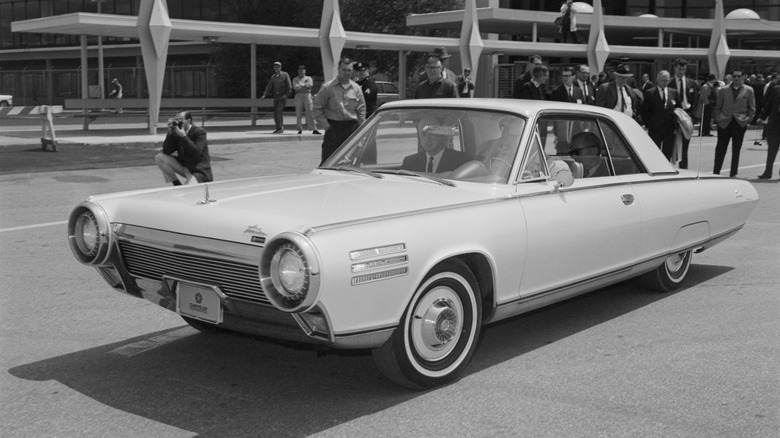What Happened To The Chrysler Turbine Car? (And Why Cars Don't Have Jet Engines Today)
The engine is the lifeblood of a car. It converts fuel, usually gasoline, into physical motion that turns the wheels and makes the vehicles go. Over the years, as technology advanced, so too did engines. Not only did car manufacturers tweak existing engines to become smaller and more fuel efficient, some unveiled innovative designs that pushed the car industry in new directions. Some also invented some pretty weird engines.
Arguably the weirdest engine to ever grace the front end of a car has to be the turbine engine. A few car manufacturers toyed with the idea, but none put as much effort into it — or did it with as much flair – as Chrysler. The company spent decades working on a turbine engine for cars and produced one of the most iconic vehicles of the early 1960s: the Chrysler Turbine Car. It's so recognizable, it doesn't even need a name. Just say the words "Chrysler Turbine Car," and most automobile aficionados will know what you're talking about. However, for all the Chrysler Turbine Car's fame, the vehicle never made it to production. All that's left of its legacy is a few car bodies and non-working engines. That and the movie "The Lively Set," which is essentially a 95-minute commercial for the car.
So what happened to the Chrysler Turbine Car? Heck, what happened to the very concept of putting jet engines in cars period? Read on to find out.
What Is a Turbine Engine?
Before the electric motor, car engines relied on internal combustion. Most used (and still use) pistons to draw in oxygen and fuel, ignite the mixture with a spark, and let the resulting miniature explosion move internal parts that both power the car and draw in even more oxygen and fuel. Turbine engines run on the same combustion principle but lack pistons, instead relying on their titular turbines.
According to the Chrysler Turbine Program's national turbine service supervisor, Bill Carry, turbine engines at their most basic function are highly mechanical pinwheels. Air flows through one end of a tube cordoned off by fan blades and enters a combustion chamber. The oxygen then mixes with fuel and ignites, blasting out the other end past another set of fan blades, making them spin. These secondary fan blades are connected to those in the front, and the faster the resulting explosive force makes them rotate, the faster they make the front fans spin. This draws in even more oxygen to react with yet more fuel. This process isn't too far removed from what takes place in a standard piston-powered car engine, but instead of a continual influx of oxygen and fuel produced by reciprocating pistons, turbine engines receive a continuous stream of oxygen and gas thanks to their rotating turbines.
The first vehicle to successfully use turbine engines was an experimental German plane, the Heinkel He 178. The aircraft only flew for 10 minutes, but it achieved a speed of almost 375 miles per hour. This test flight demonstrated that jet engines could one day replace propeller planes. After World War II, the turbine machines quickly became the go-to method of air travel propulsion.
What Was So Special About the Chrysler Turbine Car?
During World War II, Chrysler contributed to the war effort by constructing planes, tanks, and other military vehicles. The company also worked on its own turbine engine — the A86 — but by the time it was ready, the global conflict was already over. Instead of letting all their hard work go to waste, Chrysler engineers decided to adapt the design to their company's original bread and butter: cars.
Chrysler's best and brightest minds worked hard to not only miniaturize the turbine engine but also make it work with a car's driveshaft. These engineers redesigned many parts of the motor and added quite a few new components, such as a regenerator that captured hot air as it exited the exhaust and recycled it into the intake. This reduced the amount of heat required for combustion and the temperature of expelled fumes.
The company's mechanics also installed a second-stage turbine and linked that to reduction gears that powered the wheels. Even with these add-ons, the Chrysler Turbine engine had fewer moving parts than your standard piston model, which meant it was lighter and required less maintenance. You didn't even need to change the oil and could use any liquid that burned as fuel. Except for leaded gasoline — that just gummed up the works.
While the Rover Jet1 was the first car with a turbine engine, the Chrysler Turbine became the most popular thanks to the company's showmanship. Representatives drove cars powered by the engine across the United States, showed them off in college campuses (which doubled as ads for Chrysler engineering jobs), and most important of all, loaned Chrysler Turbine Cars to 203 lucky families. Recipients got to test drive the vehicles and provide feedback after their time was up. You don't see marketing campaigns like that anymore.
What Became of the Chrysler Turbine
The Chrysler Turbine Car was never mass produced, but it still lives on in the minds of car aficionados. The vehicle remains the quintessential 1960s automobile and graces several museum and personal collections. Plus, Chrysler recycled the engine's concepts and designs to help pursue ventures that would prove more profitable than commercial cars.
Out of the 55 turbine-powered cars Chrysler manufactured, only nine survived — the rest were scrapped. Most of the intact cars went to museums such as the Smithsonian Institute in Washington, D.C. and the Natural History Museum of Los Angeles, while three found homes in the Chrysler Corporations HQ in Detroit, Michigan. One particularly lucky Chrysler Turbine Car was swapped between personal collections and eventually landed in the lap of Jay Leno. What made this one so lucky? Unlike most of the others, this car's engine continued to work, at least until Leno accidentally burned it out in 2021.
In what could possibly be described as a case of cosmic irony, after Chrysler canceled its car turbine engine project (more on the whys later), the company recycled much of the progress they made to once again create military vehicles. This time, instead of working on jet planes, Chrysler engineers used their turbine engine to create a tank, specifically the M1 Abrams. And this wasn't a case of a new team picking up where the old team left off. According to Steve Lehto, author of "Chrysler's Turbine Car: The Rise and Fall of Detroit's Coolest Creation," many of the same people who worked on the Chrysler Turbine Car switched gears (pun intended) to develop the M1 Abrams' turbine engine.
Turbine Engines Aren't Fuel Efficient
As previously stated, the Chrysler Turbine Car's engines could run on anything. Unleaded gas, jet fuel, hair spray, and even Chanel No. 5 perfume. If it was a flammable fuel (and wasn't leaded), it could power the car. However, that wasn't the blessing it sounds like — no matter what you used, you'd need a lot of it.
The Chrysler Turbine Car's fuel economy issue was baked into the design because jet engines don't idle well and are infamous for burning through fuel. Chrysler turbine engineer Bud Mann colorfully compared its fuel consumption to how lions ravenously eat gazelle. While gasoline prices weren't a concern back in the day, Chrysler's expert engineers tried their best to solve the fuel issue, but there was only so much they could do.
The Chrysler Turbine Engine went through seven generations of designs, each with its own improvements. For instance, the aforementioned regenerator was placed on the engine's top until the fourth rendition. However, fuel economy was always at the forefront of these upgrades. Around the 1970s, Chrysler managed to make the engine squeeze out 10 to 12 miles to the gallon, which wasn't a huge improvement over other cars of the time. However, you could still run it on peanut oil or tequila instead of normal gas, which would have come in handy if gas prices started rising — or should we say when they started rising. The Iran-Iraq War affected the cost of gas, but after prices stabilized, many people reconsidered the need for a new engine that wasn't more efficient than the piston engine, let alone as efficient as advertised. If only they knew how high gas prices would soar in the following decades.
Turbine Engines Polluted Way Too Much
When Chrysler's engineers began the turbine engine project, they were in it for the art of creation. They wanted to build a motor that captured the spirit of the jet age and then transplant it into an automobile. But at the beginning of the 1970s, the United States Government formed a new agency that would doom the project: the U.S. Environmental Protection Agency (EPA).
The EPA was founded to maintain and enforce environmental laws, including the volume of pollutants cars could produce. Initially, the EPA worked closely with Chrysler to produce alternative power sources. To be more specific, Chrysler worked under the EPA via a government contract, which gave the company funding (more on that later) but also made it subject to the EPA's whims, i.e., its pollution standards.
To make a long story short, toxic emissions were one of the Chrysler Turbine Car's Achilles' heels. The engine spewed out nitrogen oxide, carbon monoxide, and hydrocarbons even when idling. The company's director of research, George Huebner, believed he could fix the nitrogen oxide problem by lowering the combustion chamber's temperature to 1,800 degrees Fahrenheit. For comparison, air in the Chrysler Turbine Car's engine was normally heated anywhere between 1,850 to 2,500 degrees Fahrenheit. Huebner even had the math to prove his claim, but the EPA didn't give the company's engineers a chance. Once the initial contract ran out and Chrysler hadn't delivered on it promises, especially when it came to emissions, that was it for the Turbine Car program.
Turbine Engines Cost Too Much
Chrysler has had money troubles since time immemorial. The company has declared and crawled back from the cusp of bankruptcy numerous times, and projects such as the Turbine Car have played a part in both situations. However, eventually the reality of loans and investments caught up with the company and its turbine engines.
Even though the turbine engine was lighter and had fewer moving parts than a normal piston engine, Chrysler's engineers couldn't construct them out of everyday car engine parts and materials. The company's metallurgists had to invent a new alloy that could stand up to the rigors of an automobile. However, while the cost of manufacturing a Chrysler Turbine Engine was technically cheaper than that of turbines for military vehicles, the car motor relied on prohibitively expensive materials. No matter what improvements Chrysler engineers implemented, the turbine engine always cost more than your standard piston motor.
The cost of building turbine engines didn't stop with materials. In order to manufacture and assemble them, Chrysler would have had to build a factory dedicated to that phase of production. While the company had all the necessary tooling to build the motors, Chrysler simply didn't have the money necessary to build the production plant. While the EPA worked with Chrysler (and funded the program) to get the engine's emissions levels in check, that money ran out due to a lack of interest. And also because one of the alleged conditions of the Chrysler Corporation Loan Guarantee Act of 1979 stated the company had to cancel gas turbine development for cars. Perhaps if Chrysler had the extra scratch, its engineers could have made turbine cars a reality.
